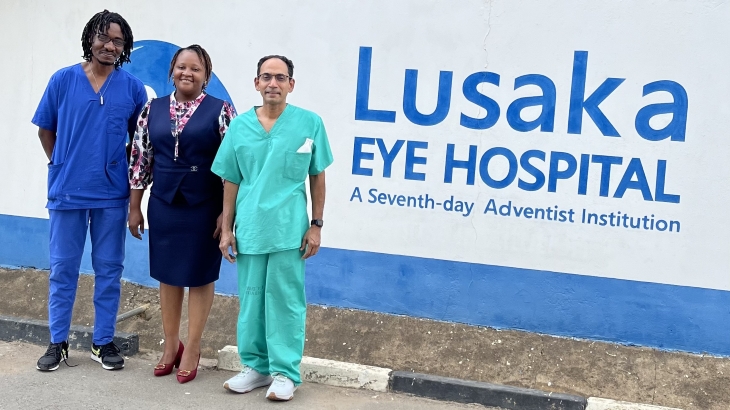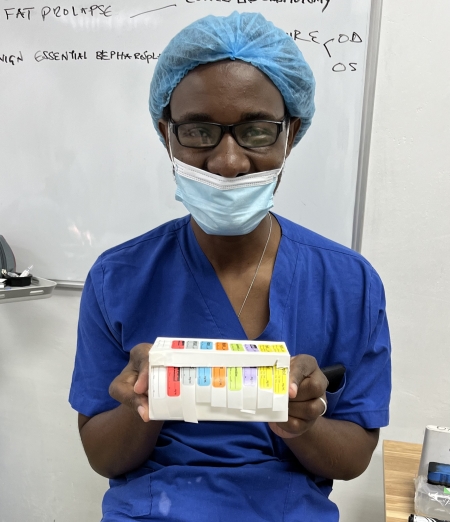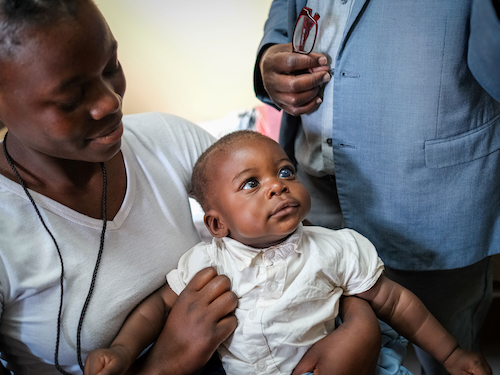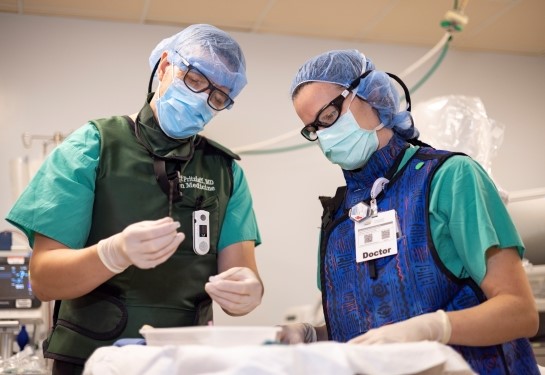UC Davis doctor trains pediatric anesthesiologists in country with critical shortage
Trip to Zambia part of UC Davis Health’s long-running commitment to global eye health with Orbis International
Last fall, Niroop Ravula, a pediatric anesthesiologist at UC Davis Health, made a 32-hour journey from Sacramento, California, to Lusaka in Zambia.
He brought with him a suitcase stuffed with 48 pounds of anesthesiology equipment and supplies — two types of laryngoscopes, which help anesthesiologists put in breathing tubes during surgery, laryngeal masks to keep patients’ airways open during anesthesia and drug labels to help physicians quickly identify medications needed in the operating room.
Zambia’s natural beauty and abundant wildlife attract hundreds of thousands of tourists every year. But the country has one of the lowest gross domestic products in the world, with two-thirds of the population living in poverty.
And like many countries, Zambia has a shortage of anesthesiologists, who are critical for patient safety and comfort during surgery.
“There are only five or six pediatric anesthesiologists for the entire country of over 20 million,” Ravula said. He notes the mortality rate for children who have surgery in low-income countries is 100 to 200 times higher than in the United States.
Helping to improve those statistics is why he made the journey.
“I grew up in a small village in India with limited access to health care,” Ravula said. “Helping train professionals in other countries has been a way for me to help bridge the gap that I experienced first-hand.”

Commitment to global eye health with Orbis dates to 2006
Ravula’s trip was organized by Orbis International, a nonprofit that works around the world to prevent blindness and restore sight in places where eye care is out of reach. Among their many global programs, Orbis is well known for the famous Flying Eye Hospital, a fully accredited ophthalmic teaching hospital on board an MD-10 plane. The Flying Eye Hospital is a state-of-the-art teaching facility complete with an operating room, classroom, recovery room, and a high-tech simulation training center.
Orbis also conducts on-site hospital trainings, like the one Ravula was on in Zambia.
UC Davis’s partnership with the nonprofit dates back to 2006. Over the years, faculty have participated in dozens of medical trainings in China, Vietnam, Peru, Nepal, Indonesia, India, El Salvador, Ethiopia, Zambia, Panama, Mongolia and many others.
Ravula became involved with Orbis in 2016 when he was asked to lead an anesthesiology training for Orbis physicians and medical staff at the UC Davis Health Center for Simulation and Education. He created a program where surgeons, anesthesiologists and nurses were put through simulations of different scenarios and crisis management situations.
Since then, he has taken part in other Orbis projects around the globe. Earlier this year, he traveled to Mongolia with the Flying Eye Hospital.
Orbis trainings empower local physicians
For Ravula, the key distinction with the Orbis model is that it emphasizes training and resources for local physicians, residents, attending physicians, medical students, surgical nurses and biomedical engineers.
“You empower the local physicians and their teams with training and resources so they can continue offering the surgeries, which can then impact thousands of patients,” Ravula said.
His medical specialty — anesthesiology — is increasingly in demand. A recent report estimated that by 2036, there will be a shortage of at least 6,300 anesthesiologists in the United States. But the shortage is everywhere.
"There’s a global shortage of anesthesiologists. This means the current workforce is overworked and undervalued,” said Andrew Choyce, provisional anesthesiologist with the Orbis Flying Eye Hospital. “All anesthesia providers need support in training and education to feel valued as a fundamental part of the surgical team, including eye care.”
In Africa, the current shortage of anesthesiologists is especially acute. Of the 46 countries that make up sub-Saharan Africa, 43 have fewer than one anesthesiologist per 100,000 population. By comparison, the U.S. has an estimated 20 per 100,000 population.

Surgeries treat range of eye diseases
Before Ravula and the rest of the Orbis team arrived, ophthalmologists at the Lusaka Eye Hospital identified more than 30 patients who were candidates for oculoplastic surgeries, which are surgeries on or around the eyes.
After his arrival, Ravula met the Zambian junior anesthesiologists he would be working with during the week, Henry Nchimunya and Hazel Sonkwe.
Although many eye procedures can be done using numbing drops — such as cataract surgery, where a cloudy lens is replaced with an artificial lens — general anesthesia is needed for many eye surgeries.
Many of the patients had tumors on their eyelids or tumors within the eye. One child had blocked tear ducts and needed stents so the eyes could drain. One young baby, born premature, was deemed too small for surgery but would be able to get surgery when it was older. A few patients had ptosis, where the upper eyelid droops over the eye.
More than 25 patients were treated while the Orbis team was at the hospital. Local teams were also trained so that they could continue offering surgeries at the hospital.
“This is why I enjoy volunteering with Orbis. I feel that I can make a tangible difference helping these patients and communities,” Ravula said.

Anesthesiologists manage pain and overall health
Ravula’s role was administering anesthesia, so the patients did not feel pain or discomfort during the procedures.
Anesthesiologists also continually monitor the patient’s vitals — breathing, blood oxygen, heart rate, temperature and much more — ensuring everything is functioning normally.
“An anesthesiologist is a perioperative physician,” Ravula explained. “They partner with the surgeons and work with the patients before, during and after surgery to make sure they have good outcomes.”
He sees multiple factors affecting the current shortage: physicians retiring, more procedures that need anesthesiology and fewer medical students picking anesthesiology as a specialty.
As a young medical student, Ravula wasn’t sure which area of medicine he wanted to specialize in. And initially, he was intimidated by the operating room.
“Everybody was saying, ‘Don’t touch this!’ And ‘Don’t touch that!’” Ravula said. “So, I ended up standing in the corner.” However, a physician on the anesthesiology team pulled him in and started explaining the physiology and pharmacology.
“Once you absorb yourself into it, anesthesiology is just a fascinating specialty,” Ravula said.
Orbis trip could lead to future partnership
At the Lusaka Eye Hospital, Ravula enjoyed working with his younger Zambian colleagues. He trained them on current anesthesiology tools that are standard in the U.S., such as a reusable video laryngoscope for airway management in infants. He also shared his expertise on safety principles, crisis management in pediatric anesthesia and syringe labeling to reduce drug errors.
Ravula is hoping to create an ongoing partnership between physicians at UC Davis and the Lusaka Eye Hospital. He noted that the learning experience goes both ways, with physicians learning about the unique health conditions in the countries they are visiting.
“By returning to the Lusaka Eye Hospital, we can see what else might be tweaked or improved. We can continue to build on the existing building blocks, resulting in huge health benefits for the people in Zambia,” Ravula said.
Resources
- Orbis and UC Davis Team Up to Train Eye Care Teams from Latin America to Fight Avoidable Blindness
- Eye Doctors Fly to Africa (via Davis Enterprise)
- Orbis, UC Davis surgery team train on world's only Flying Eye Hospital






